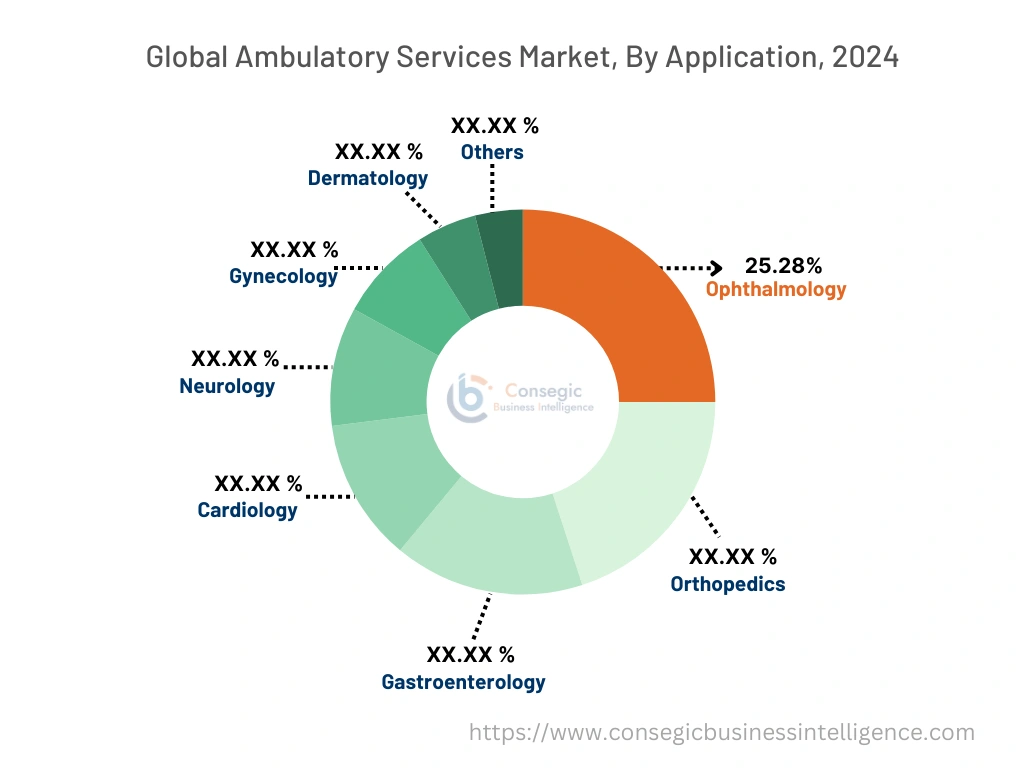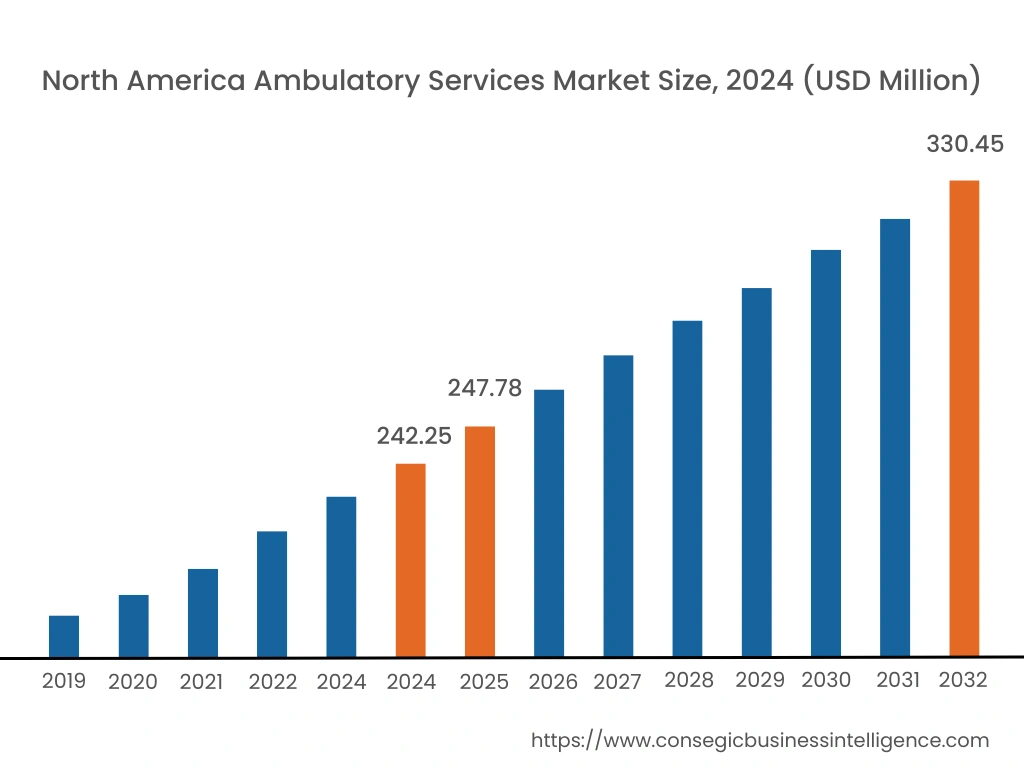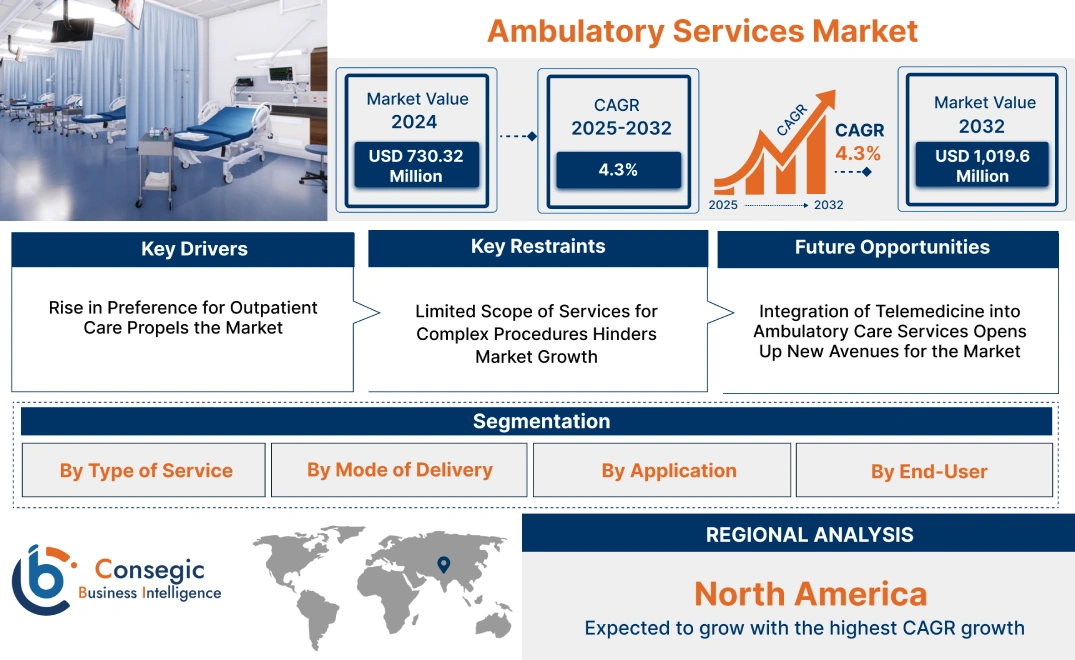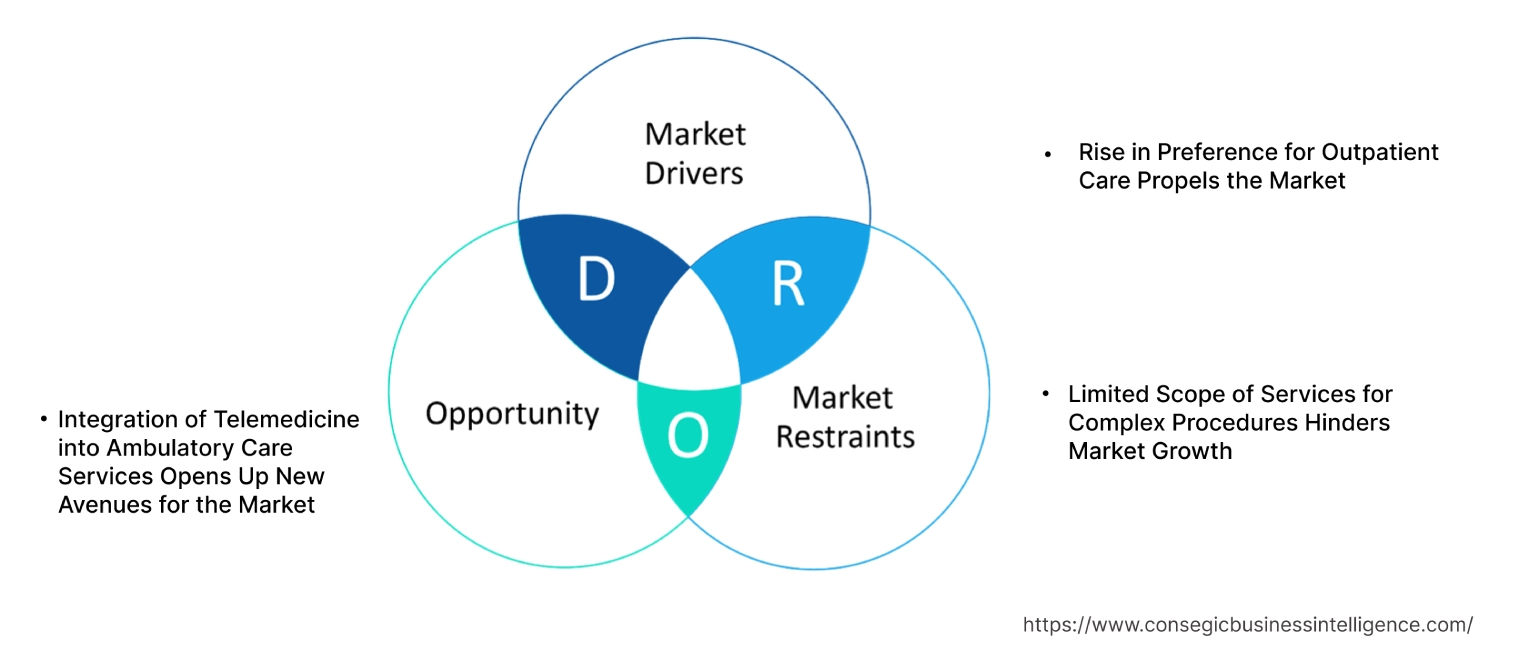- Summary
- Table Of Content
- Methodology
Ambulatory Services Market Size:
Ambulatory Services Market size is estimated to reach over USD 1,019.60 Million by 2032 from a value of USD 730.32 Million in 2024 and is projected to grow by USD 748.41 Million in 2025, growing at a CAGR of 4.3 % from 2025 to 2032.
Ambulatory Services Market Scope & Overview:
Ambulatory services are defined as the medical care offered on an outpatient basis. This means that a patient would get a diagnosis, treatment, and preventive care on the day without staying overnight at the admitted facility. The key components of ambulatory services include outpatient care, minor surgical procedures, emergency services, physical therapy, and specialty care. They also offer diagnostic services like lab tests, X-rays, CT scans, etc. Ambulatory services focus on offering high-quality and satisfactory medical care while lowering hospital admission costs. They have a myriad of other benefits, such as the easy convenience of minimizing time spent in a hospital which lessens the risk of catching infections. It also results in better patient health outcomes in the long term. They are employed within various industries, such as hospitals, clinics, private practices, etc.
Ambulatory Services Market Insights:
Key Drivers:
Rise in Preference for Outpatient Care Propels the Market
Outpatient care offers more affordable medical attention reducing the need for frequent long-term hospital admissions. This results in minimum overhead costs, which tends to be beneficial for both healthcare workers and patients. Outpatient care is also less invasive. It results in efficient surgeries and allows patients to have a speedy recovery without the heightened risk of frequent complications. This type of medical care is more convenient for patients, especially the aging demographic. The provisions of reduced waiting times and short visitations are helpful for patients who tend to avoid the stressful environment of inpatient care.
- A recent study conducted by Strata Decision Technology and Syntellis Performance Solutions presented a report that articulates the rise in demand for outpatient care services in the US. The study highlights how patients are opting out of inpatient care to choose outpatient care, especially for orthopedic procedures, knee surgeries, hip replacement techniques, etc.
Therefore, as healthcare policies shits to encourage outpatient care as a cost-effective measure, it results in ambulatory services market expansion.
Key Restraints :
Limited Scope of Services for Complex Procedures Hinders Market Growth
Ambulatory outpatient services often lack the high-tech infrastructure, specialized equipment, and enhanced medical technologies that ensure the smooth functioning of complex surgeries. For example, multi-organ transplants or open-heart surgery require intensive care, expert surgical teams, and immediate post-operative recovery monitoring. This is more suitable for inpatient care than outpatient care. Ambulatory facilities are also not equipped to handle medical emergencies, such as severe bleeding. In situations like these, patients often need critical emergency care, limiting the efficiency of ambulatory care settings. Moreover, ambulatory centers offer basic anesthesia which is not effective for deep sedation.
- A report published in October 2023 by the National Library of Medicine (NLH) discusses the safety concerns related to the functioning of complicated procedures for patients under the current ambulatory outpatient services. The study also highlights the ongoing challenges faced by anesthesiologists in maintaining patient safety through knowledge of the proper patient selection, method, and surgical site.
Therefore, as patient safety and risk management are highly curbed by limited resources of services, the ambulatory services market growth is evidently limited.
Future Opportunities :
Integration of Telemedicine into Ambulatory Care Services Opens Up New Avenues for the Market
Telemedicine offers patients, particularly from remote locations, easy access to ambulatory outpatient care without physically visiting a healthcare center. The patients can conveniently have follow-up visits, virtual consultations, etc. from the comforts of their homes. This flexibility raises patient satisfaction and engagement. It makes getting medical care cost-effective too, which encourages the patients to seek timely ambulatory care. Telemedicine also is especially helpful in the management of chronic illnesses, such as diabetes, heart ailments, etc. as they require regular monitoring and intermittent follow-ups. For ambulatory surgery centers (ASCs) telemedicine streamlines preoperative checkups via virtual consultations by assessing the patient's fitness for surgery. It also helps in determining the post-operative recovery rates of patients by addressing residual issues. This lowers the probability of complications which conventionally requires emergency visits.
- For instance, Washington County Regional Medical Center in Georgia provides its patients with telemedicine services in rural areas. It is supported by the PAVES network. They provide emergency care services through a mobile system that links the patients with medical professionals.
Thus, the ambulatory services market opportunity grows with the incorporation of telemedicine as it optimizes the influx of patients and ensures operational efficiency.
Ambulatory Services Market Segmental Analysis :
By Type of Service:
The market is segmented based on type of service into Primary Care Offices, Emergency Departments, Surgical Centers, Outpatient Departments (OPD), Rehabilitation Centers, Diagnostic Centers, Telehealth Services, and others.
Trends in the Type of Service:
- Recently, ambulatory outpatient care offers behavioral treatments to monitor the balance between mind and heart health.
- In recent years, advanced biotechnologies have been leveraged for building robots to help medical professionals offer Ambulatory outpatient care in diagnostic or surgical centers.
Primary Care Offices accounted for the largest revenue in the ambulatory services market share in 2024.
- Primary care like routine checkups and preventive care lays the groundwork for the first point of contact in medical care for patients.
- The expansion of patient-centered medical homes (PCMH) models where the focus lies on team-based care boosts the need for primary care offices.
- They are cost-effective as compared to specialty clinics or high-end hospitals. This makes them attractive to insurers and patients.
- The growth of the aging demographic raises the market demand for primary care services for managing chronic illnesses.
- Therefore, the regulatory approvals for primary care services contribute to its position in the ambulatory services market demand.
Telehealth Services are expected to have the fastest-growing CAGR during the forecasted period.
- Telehealth services offer patients access to a wide range of medical care without requiring them to travel to medical facilities. This cuts down on physical costs and time associated with hospital visitations.
- Insurance companies tend to cover telehealth visitation charges at rates that are equal to in-person visits. The financial incentives make telehealth attractive to both medical workers and patients.
- These services are increasingly effective in the management of chronic conditions such as diabetes. They offer easy regular monitoring and efficient follow-ups.
- For instance, Mayo Clinic offers telehealth service to their patients and makes it easier for them to get expert medical advice from medical specialists.
- Thus, as per the analysis, telehealth services have seen expansion as patients shift to preferring virtual consultations over physical ones.
By Mode of Delivery:
The market is segmented based on the mode of delivery into In-Clinic, Telemedicine, Mobile Healthcare Services, and Home Care Services.
Trends in the Mode of Delivery:
- There is a trend of leveraging Artificial Intelligence (AI) algorithms to collect analytical data on patients, store medical records, etc.
- Recently, online retail pharmacies, such as MedPlus, have emerged as a sub-branch for mobile healthcare services.
In-Clinic Services accounted for the largest revenue in the ambulatory services market share in 2024.
- Patients prefer to avoid the stressful environment of hospitals, and in-clinic outpatient care is less expensive and convenient.
- They offer a variety of outpatient services such as minor and minimally invasive surgical procedures, daily checkups, diagnostic tests, etc.
- Many in-clinic services provide specialized care such as dermatology, orthopedic care, etc., making it more attractive for patients.
- They offer a personalized and easy approach to medical expertise as patients receive precise and continuous care.
- Therefore, as in-clinic services offer patient-centric ambulatory care, they drive the ambulatory services market growth.
Telemedicine is expected to have the fastest-growing CAGR during the forecasted period.
- Telemedicine offers virtual consultations to patients, especially in regions where physical healthcare is limited.
- The patients have access to medical expertise at any time, lowering the need to wait for an appointment, and making telemedicine a more convenient option.
- Telemedicine reduces overhead operational costs and cuts down the costs that are associated with physical inpatient care.
- Telemedicine is more reliable and efficient as it depends on internet connectivity or portable wearable devices.
- For instance, ADLINK Technology Inc. (Taiwan) is an embedded computing product and edge computing solution firm that offers ambulatory telemedicine for emergency medical services (EMS). They offer real-time patient data to the medical facilities which helps in remote diagnosis and primary care.
- Thus, as per analysis, telemedicine is being increasingly adopted in the post-covid world, due to its efficient and accurate diagnosis. This, in turn, drives the ambulatory services market trends.
By Application:
The market is segmented based on application into Ophthalmology, Orthopedics, Gastroenterology, Cardiology, Neurology, Gynecology, Dermatology, and others.
Trends in the Application:
- As a modern trend, patient-centered care has given rise to more customized and effective outpatient treatment opportunities.
- Many female patients are opting for cost-effective outpatient gynecological care to address issues such as Polycystic Ovary Syndrome (PCOS).
Ophthalmology accounted for the largest revenue share of 25.28% in the ambulatory services market in 2024.
- Ophthalmology care such as LASIK, cataract surgeries, or treatment of macular degeneration or glaucoma has a high demand.
- Ambulatory ophthalmic outpatient services offer cost-effective treatment procedures, unlike inpatient services.
- Ambulatory outpatient care offers minimally invasive surgical techniques and diagnostic tools, enhancing efficiency and recovery times.
- In ophthalmic treatments, ambulatory outpatient care offers speedy and more convenient medical attention, streamlining the procedures which makes inpatient care lengthy.
- For instance, in July 2022, an article was published on the National Library of Health (NLH) highlighting the influence of ambulatory services in ophthalmology emergency clinics. The study concluded that outpatient care is instrumental in enhancing treatment quality, outcome and patient satisfaction. There is less wait time for the patients, and the resident doctor is provided with an impressive learning environment.
- Thus, as per the ambulatory services market analysis, ophthalmology outpatient care's affordability contributes to its largest revenue generation.
Cardiology is expected to have the fastest-growing CAGR during the forecasted period.
- Cardiovascular conditions such as strokes, heart attacks, heart failures, hypertension, etc. have increased exponentially, driving the needs for cardiological outpatient services.
- Certain cardiological procedures are becoming minimally invasive such as cardiac catheterizations, percutaneous coronary interventions (PCI), electrophysiology, etc. This makes it easy to conduct heart treatments in an outpatient setting.
- The advancement of new technologies like advanced imaging (echocardiography), portable devices (fitness trackers with heart rate monitors), etc. has enabled doctors to effectively diagnose patients in outpatient settings.
- Outpatient cardiology services offer intermittent screenings, stress tests, heart rate monitoring, etc. This makes cardiological ambulatory care proactive and effective.
- Therefore, as per the analysis, governments are encouraging ambulatory cardiology care adoption, leading to its fast growth.

By End-User:
The market is segmented based on end-users into Hospitals, Ambulatory Surgery Centers (ASCs), Clinics & Physician Offices, Home Healthcare Providers, and others.
Trends in the End-User:
- It is a growing trend for ASCs to utilize cloud computing to store patient records, also known as electronic health records (EHRs).
- Recently, there has been a high requirement among patients for comprehensive care, which propels hospitals to adopt ambulatory outpatient services.
Hospitals accounted for the largest revenue share in 2024.
- Hospitals offer a broader spectrum of outpatient care other than surgery such as diagnostic testing, emergency care, imaging services, physical therapy, and specialized treatments.
- They have a long-term and wider patient base due to their full-service capabilities. This makes them more trustworthy to patients.
- They have integrated treatment models, offering both inpatient and outpatient care. This arrangement results in more referrals within their network for follow-up outpatient processes.
- Hospitals have state-of-the-art medical technologies such as automatic surgery systems, MRI machines, etc. This allows them to provide more efficient therapeutic and diagnostic outpatient care.
- Therefore, as per the analysis, hospitals saw an expansion for outpatient care, especially in the post-pandemic world.
Ambulatory Surgery Centers (ASCs) are expected to have the fastest-growing CAGR during the forecasted period.
- Ambulatory surgery centers (ASCs) provide outpatient care at lower costs, making them beneficial for patients and insurers.
- ASCs have a convenient and less tense atmosphere, unlike hospitals. They have shorter waiting times and offer efficient time scheduling for patients who seek elective surgeries and other outpatient care.
- ASCs have an attractive outlook on the aging demographic as the steady rise of chronic diseases necessitates flexible surgical intervention.
- Thus, as per the analysis, the growing support of governments and insurers in favor of using ASCs underscores its provisions for fast growth in the future. Thus, in turn driving the ambulatory services market trends.
Regional Analysis:
The regions covered are North America, Europe, Asia Pacific, the Middle East and Africa, and Latin America.

North America is valued at USD 242.25 Million in 2024 and is projected to grow by USD 330.45 Million in 2032. Out of this, U.S. accounted for the maximum revenue share of 67.25%.
In North America, the healthcare system highly focuses on value-based care. This means that healthcare workers are more sought after for the quality of their care than the number of patients they diagnose per day. This makes ambulatory services attractive to the demographic population in this region as they offer minor surgeries, intermittent checkups, etc. which are also covered in health insurance packages.
- For instance, according to an article published by the University of North Carolina in 2021, ambulatory services have gained popularity in outpatient care. The shift is the result of the change in health insurance reimbursement models. This means that the patients get more value-based care and optimal payment policies.

Asia Pacific (APAC) region, especially in countries like China, India, Japan, etc., where the prevalence of chronic diseases is quite high, ambulatory healthcare is much sought after. These services provide outpatient care without burdening patients with enormous admission fees, making them cost-effective.
- In 2024, the Philippines established the Bagong Urgent Care and Ambulatory Service (BUCAS) center in Pampanga. It offers a varied range of outpatient healthcare services pediatric care, on-site pharmaceutical care, laboratory services, etc. The center also provides diagnosis and preventive treatment.
Europe is home to the highest number of aging demographics and this demands ongoing medical care. Inpatient services often become frenzied for patients, especially those having chronic conditions such as cardiovascular diseases arthritis, etc. This has raised the ambulatory services market demand in the region.
The Middle East and Africa (MEA) is focused on medical infrastructural development and the governments have seen investing heavily in the healthcare industry. It has led to the growth of ambulatory care centers as they are more reliable to the broader population. The ambulatory services market analysis depicts that in the Latin American region, especially Mexico, Chile, Brazil, etc. has utilized the provision of telemedicine and digital healthcare industry to expand the reach of outpatient services.
Top Key Players & Market Share Insights:
The ambulatory services market is highly competitive with major players providing products and services to the national and international markets. Key players are adopting several strategies in research and development (R&D), product innovation, and end-user launches to hold a strong position in the global ambulatory services market. Key players in the ambulatory services industry include:
- TH Medical (USA)
- Envision Healthcare (USA)
- HCA Management Services, L.P. (USA)
- DaVita Inc. (USA)
- Terveystalo (Finland)
- Fresenius Medical Care Asia Pacific Limited (Germany)
- Universal Health Services (USA)
- CHSPSC, LLC. (USA)
- Ramsay Health Care (Australia)
- Pediatrix Medical Group (USA)
Recent Industry Developments :
Product Launches:
- In December 2023, Cleveland Clinic (London) announced the launch of a new medical care center for outpatient activity. They aimed to offer patients with speedy access to expert consultants, specialists, and novel medical technology. It would increasingly enhance outpatient care and safety without compromising medical ethics and quality.
- In July 2024, HSE (Health Service Executive) announced the launching of an online outpatient action database. This online portal will publicly display hospital outpatient attendance by hospital (21 hospitals), specialty, and region. The data would be updated every month. Through this, HSE aims to maximize outpatient activity and lower outpatient waiting time.
Mergers and Acquisitions:
- In January 2024, Veradigm Inc. announced its acquisition of Koha Health. Veradigm is a healthcare data and tech solutions provider while Koha Health is a revenue recycle management (RCM) full-service company. This strategic acquisition cements Veradigm's position as a premium RCM service provider in the ambulatory market. It also gives Veradigm access to expand its services in various sectors such as ambulatory surgical centers (ASCs).
Partnerships and Collaborations:
- In September 2024, HST Pathways and SYNERGEN Health announced their partnership. This collaboration is aimed at improving RCM services for ambulatory healthcare. HST is a cloud-based software solution provider for ACS services while SYNERGEN is a tech-based RCM service provider. This partnership would ASC performance through the provision of precise, live financial data analysis, the minimization of errors, and the acceleration, and efficiency of billing procedures.
Investments and Funding:
- In January 2024, TPG announced its intention to invest in Compass Surgical Partners. This investment is aimed at enhancing growth and scaling capability in response to the growing demand for ASC joint ventures.
Ambulatory Services Market Report Insights :
| Report Attributes | Report Details |
| Study Timeline | 2019-2032 |
| Market Size in 2032 | USD 1,019.60 Million |
| CAGR (2025-2032) | 4.3% |
| By Type of Service |
|
| By Mode of Delivery |
|
| By Application |
|
| By End-User |
|
| By Region |
|
| Key Players |
|
| North America | U.S. Canada Mexico |
| Europe | U.K. Germany France Spain Italy Russia Benelux Rest of Europe |
| APAC | China South Korea Japan India Australia ASEAN Rest of Asia-Pacific |
| Middle East and Africa | GCC Turkey South Africa Rest of MEA |
| LATAM | Brazil Argentina Chile Rest of LATAM |
| Report Coverage |
|
Key Questions Answered in the Report
How big is the ambulatory services market? +
Ambulatory Services Market size is estimated to reach over USD 1,019.60 Million by 2032 from a value of USD 730.32 Million in 2024 and is projected to grow by USD 748.41 Million in 2025, growing at a CAGR of 4.3 % from 2025 to 2032.
Who are the major players in the ambulatory services market? +
The major players in the market include HCA Management Services, L.P. (USA), TH Medical (USA), Envision Healthcare (USA), Fresenius Medical Care Asia Pacific Limited (Germany), DaVita Inc. (USA), Universal Health Services (USA), CHSPSC, LLC. (USA), Ramsay Health Care (Australia), Pediatrix Medical Group (USA), Terveystalo (Finland)
What specific segmentation details are covered in the ambulatory services market report? +
The ambulatory services market is segmented into type of service, mode of delivery, application, and end-user industry.
Which is the fastest-growing region in the ambulatory services market? +
Asia Pacific is the fastest-growing region in the ambulatory services market.


